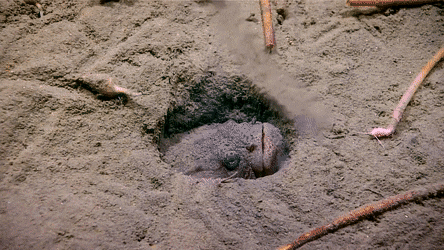
This Creepy Hole-Fish Is So Excited to Eat Literally Anything

A new undersea video is going viral for all the right reasons. Specifically: fish-on-fish-on-snail action, as well as a shocking twist.
The video, released by the National Oceanic and Atmospheric Administration's (NOAA) Ocean Exploration and Research Program, opens on a scene somewhere off the coast of the Southeastern United States, where an an Atlantic midshipman fish (Porichthys plectrodon) lays in wait, buried face-up in a shallow hole. Arrayed around its grim, ugly face are the local invertebrate bottom-dwellers, a sea snail and several quill worms. They all inch toward the precipice as if they're curious, apparently oblivious to the danger.
"It's a race to the burrow," an unseen NOAA researcher says over the video's spooky music. "The snail is winning."
The researcher seems unaware of what's going to come next, and indeed it looks as if the snail might march carelessly right into the not-very-well-hidden trap.
But then...
...a shock of blue enters from the left of the frame, as if hurtling deliberately into the hole. It's a barracudina in the family Paralepididae, according to a NOAA statement. A substance like dark, liquid smoke rises from the hole to fill the frame as predator and prey briefly struggle. When it clears, neither are visible. Only the snail remains, still perched on the very edge of the hole while the quill worms look on.
In one final moment of strange undersea grace, the snail leans too far past the edge of the burrow and plunges in as well.
Sign up for the Live Science daily newsletter now
Get the world’s most fascinating discoveries delivered straight to your inbox.
The video was collected as part of NOAA's 2018 Windows to the Deep expedition, a series of robotic dives from the ship Okeanos Explorer to explore the region off the eastern coast of Florida, Georgia, and the Carolinas.
Editor's note: This story was updated at 10:15 am Eastern, July 20 to correct the name of the fish captured. It was a barracudina, not a barracuda.
Originally published on Live Science.











